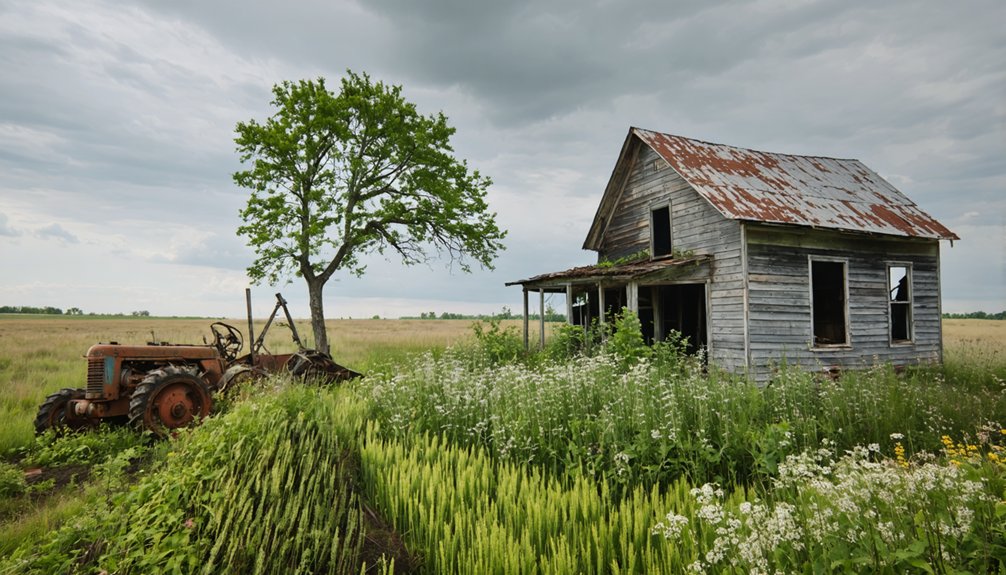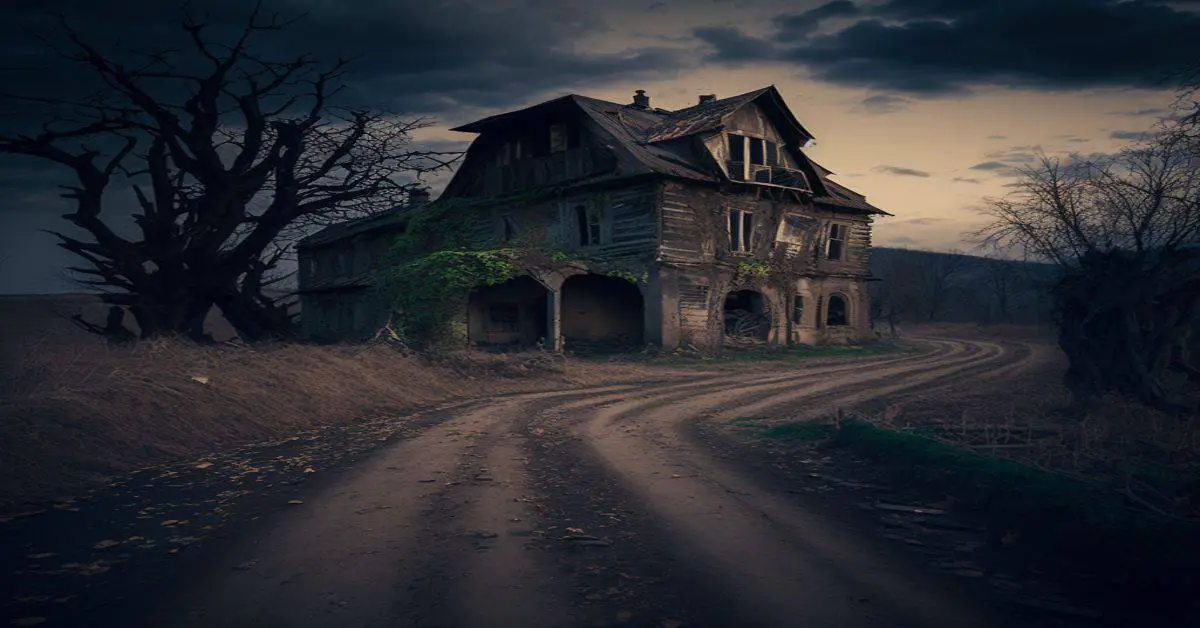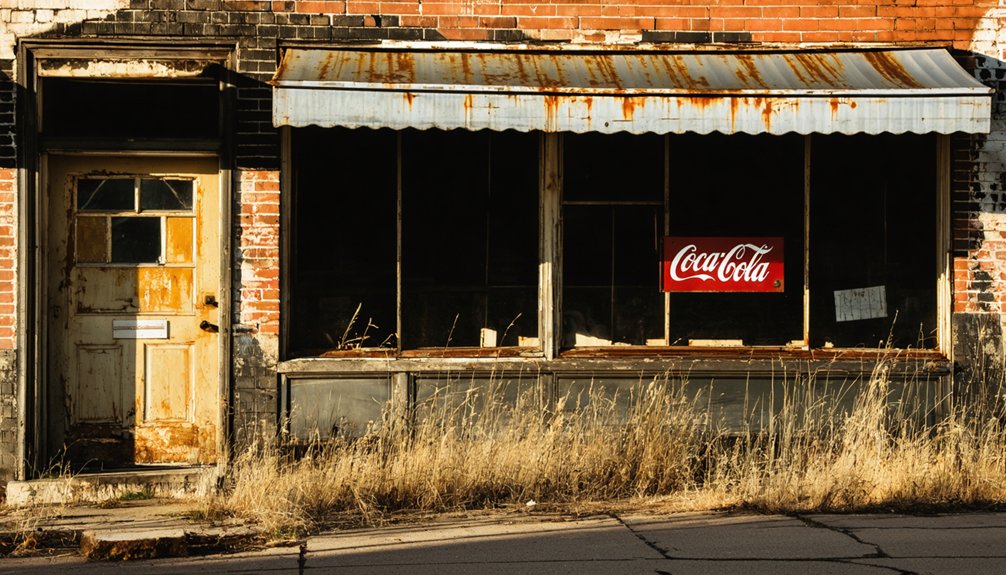You’ll discover the abandoned town of Cardiff tucked away in central Illinois, where Welsh immigrants established a thriving coal mining community in the late 1800s. The town boasted advanced mining technology, vibrant cultural traditions, and strong social connections through churches and festivals. Though Cardiff’s glory days ended with mine closures after World War I, today’s scattered foundations and overgrown pathways hold countless stories of its coal-driven past.
Key Takeaways
- Cardiff was a thriving Welsh mining town in Illinois that became abandoned after coal demand declined in the early 20th century.
- The town’s economy collapsed following mine closures after World War I and the redirection of vital rail lines.
- Once-bustling streets are now covered by wild vegetation, with only scattered foundations and building remnants visible through undergrowth.
- Welsh immigrants established churches, schools, and cultural organizations, all of which were eventually abandoned as residents left.
- Archaeological evidence, including old roadbeds and structural remains, preserves the history of this former coal mining community.
A Welsh Mining Legacy
Pickaxes and pit lamps marked the beginning of Cardiff’s profound Welsh influence in Illinois during the late 19th century.
You’ll find the town’s very name echoes the homeland these determined immigrants left behind, carrying their mining expertise across the Atlantic to build a new life in America’s heartland.
As you explore Cardiff’s history, you’ll discover how Welsh traditions became deeply woven into the community’s fabric.
Despite economic challenges that came with their heavy reliance on mining, these resilient settlers established churches, schools, and cultural organizations dedicated to preserving their heritage.
They introduced advanced mining technologies that transformed coal extraction methods, while their traditional festivals, like the Eisteddfod, brought vibrancy to the growing settlement.
Through their cultural preservation efforts, Cardiff’s Welsh pioneers left an indelible mark on Illinois’ industrial landscape.
The Rise of a Coal Empire
The discovery of rich coal seams in Cardiff’s soil marked the dawn of an industrial powerhouse in late 19th century Illinois.
You’d have witnessed the rapid transformation as the Cardiff Coal Company built an impressive network of mines, shafts, and rail lines. The strategic rail connections to Chicago and St. Louis revolutionized coal transportation, turning Cardiff into a thriving hub of commerce.
As production soared, innovations in mining technology enhanced both efficiency and miner safety. Steam-powered equipment and improved ventilation systems made the mines more productive and safer for the diverse workforce of Welsh, Italian, and Eastern European immigrants.
The wealth generated from coal exports fueled the town’s growth, establishing Cardiff as one of Southern Illinois’ premier coal producers by the early 1900s.
Life in Cardiff’s Golden Age
During Cardiff’s peak years in the early 1900s, you’d have found a vibrant community where coal miners’ wages fueled a bustling local economy.
You could’ve spotted mining families living in wooden frame houses, gathering at local churches, and shopping at general stores in the central business district. Community traditions flourished through social clubs, festivals, and dances that brought everyone together.
Walking through town, you’d have noticed the cultural mosaic of Welsh, Irish, and Eastern European immigrants who’d made Cardiff their home.
While amenities were basic, with dirt roads and communal wells, the strong social fabric made up for these simplicities. Children attended local schools while railroads kept the town connected to the outside world, transporting both coal and passengers to neighboring communities.
The Town’s Dramatic Decline
As coal demand plummeted in the early 20th century, Cardiff’s once-thriving economy crumbled beneath the weight of emerging competition from oil and natural gas.
You’d have witnessed a perfect storm of economic factors converge – mines shuttering after World War I, rail lines redirecting away from town, and the brutal impact of the Great Depression.
The population shifts were dramatic. Young residents fled to industrial cities seeking work, while those who stayed behind watched their community wither.
Schools emptied, businesses closed, and property values collapsed. Even attempts to pivot toward agriculture failed due to depleted soil and poor market access.
What Remains Today
Walking through Cardiff today, you’ll find nature steadily reclaiming what humans left behind. Wild grasses and native vegetation now blanket the historical remnants of what was once a bustling Illinois town. You can still spot scattered foundations of old homes and businesses peeking through the undergrowth, silent witnesses to the community’s past.
The site holds archaeological significance, with crumbling pathways and weathered structures offering glimpses into daily life from another era. Local historical societies work to document and preserve these remaining features, though time continues its relentless march.
If you’re interested in exploring, you might discover old roadbeds, building fragments, and other artifacts that tell the story of Cardiff’s former residents, though you’ll need to look carefully beneath nature’s growing embrace.
Frequently Asked Questions
Were There Any Documented Paranormal Activities in Cardiff’s Abandoned Buildings?
You’ll find several documented paranormal investigations showing ghost sightings, EVP recordings, and unexplained lights in Cardiff’s buildings, particularly near the old mine shafts and miners’ boarding house since the 1930s.
What Happened to the Wealth Accumulated by Cardiff’s Most Successful Mine Owners?
You’ll find that wealth distribution from Cardiff’s mine owners followed typical patterns: they invested in real estate, passed fortunes to heirs, diversified into other businesses, and left mine owner legacies through local developments.
Did Any Famous Historical Figures Ever Visit Cardiff During Its Peak?
Precious few prominent persons passed through Cardiff’s portals. You won’t find records of historical visits by famous residents or national figures during the town’s heyday as a mining community.
Were There Any Significant Archaeological Discoveries Made After Cardiff Became Abandoned?
You’ll find fascinating archaeological findings throughout Cardiff’s ruins, including household ceramics, mining equipment, children’s toys, and railroad fragments. These abandoned artifacts reveal intimate details of early 20th-century daily life.
How Many Welsh Family Descendants From Cardiff Still Live in Grundy County?
While estimates show just 2-3% of Grundy County’s population claims Welsh heritage today, you’ll find only a few hundred direct descendants from Cardiff’s original families still maintaining their Welsh family connections locally.



